Everything you need to know about Dalmatians

Dalmatians are known throughout the world for their unique spotted color. These dogs are distinguished by a high level of intelligence, ability to train, as well as incredible activity that can be both amusing and uncomfortable. This article will consider all the known information about the Dalmatians: the history of the origin of the breed, their way of life, dietary habits and training.
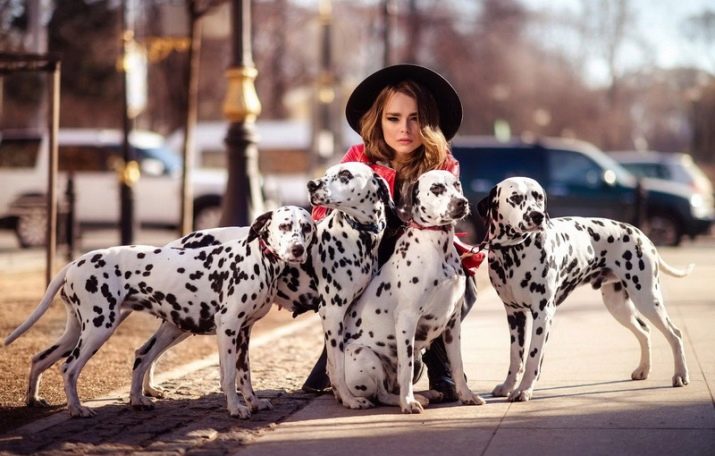
Origin story
Unfortunately, the exact origin of the Dalmatians is not known. These extraordinary dogs are sometimes mentioned in ancient historical documents. However, these data are not enough to state with certainty about the ancestors of this breed, as well as the region of its origin.
The development of the breed can only be clearly traced from the 16th century. Dogs reminiscent of modern Dalmatians have often been depicted on art objects, signs, and advertisements. These could be theatrical posters, where Dalmatians were participants in the program, or portraits of socialites and nobles with their unusual spotted pets.
Perhaps the most significant document proving the antiquity of these dogs are images in religious temples. For example, images of spotted dogs are present in the elements of the altar painting of the Church of St. Mary (town of Lošinj), in the fresco of the Franciscan church (Zaostrog), as well as in some fragments of the frescoes of the church of Santa Maria Novella.
It is worth saying that the Dalmatians received the greatest popularity on the canvases of artists from Tuscany, in their works dogs were depicted in the company of their noble owners... A striking example is Cosimo II Medici (1590-1621) - a Tuscan duke who was often depicted in the company of his beloved Dalmatian. The same applies to canvases depicting his son Francesco Medici and his beloved dog.

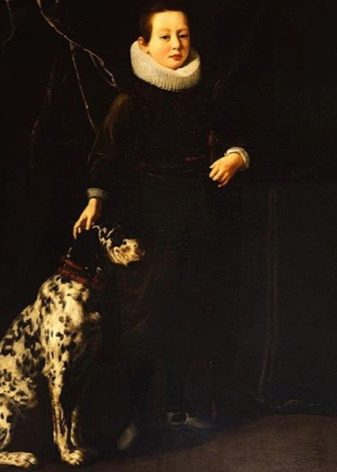
The fact is that the very first mentions of this dog breed were found in the historical region of Dalmatia, which today belongs to Croatia. It is thanks to the consonance in the name of the region and the breed that Croatia is considered to be the tribal homeland of this breed.
The first naturalist to give this breed an official name was Thomas Pennant. In his work "Synopsis of tetrapods" the scientist included the breed in the general classification of Tuscan breeds and gave these dogs the name Dalmatian. It is believed that the Roman Catholic Archdiocese of Djakovo-Osijek is involved in the creation of this name. It was in her archival documents that records from the early 18th century were found describing a breed called Canis Dalmaticus. It was indicated that these dogs have a conformation and color that is unique for Croatia.
From about the beginning of the 19th century, the breed began to actively spread throughout Europe., however, it received the greatest popularity in Britain. First of all, British breeders started breeding the breed, since not so many individuals were brought to the country, and there were more and more people wishing to acquire them. In the breeding process, genetic material from other dog breeds was used, in particular, black pointers and white English terriers. These breeds were also used to create many other modern dogs: Bulldogs, Bull Terriers, Staffordshire Terriers and some others.

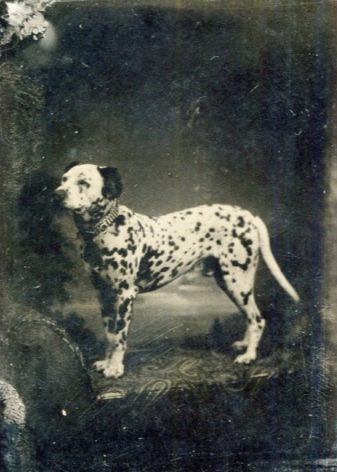
It is believed that it was thanks to the activities of British breeders that the Dalmatian breed was finally able to form and strengthen itself among other varieties.
Today it is not difficult to explain the popularity of these dogs at that time. In addition to their original and unlike anything else in color, the Dalmatians had amazing endurance and speed, which allowed them to move over great distances without any problems. In addition to decorative purposes, Dalmatians acquired the qualities of a protector - they were often taken on trips as guardians of property. As a rule, these dogs were driven away from carts with provisions for thieves and wild animals. A little later, the Dalmatians began to ascribe the status of carriage-type dogs - they were taught not only to guard luggage, but also to urge horses on, biting their legs when the pace of the trip slowed down.
In private households, the Dalmatians also played a role. They were wonderful companions, watchmen, and sometimes took part in hunting and tracking down game. Women of fashion often took these animals for a walk in the dark - these dogs perfectly guarded the ladies from criminals, rapists and thieves. For a time, the presence of Dalmatians at the court of nobles meant their high status.
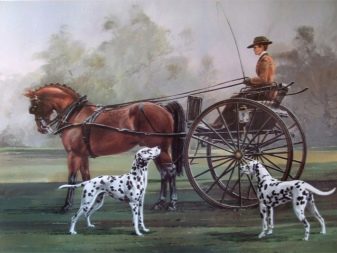

Once on American soil, the Dalmatians lost their direct purpose. At that time, carriages that transported water were actively used to extinguish fires. Horses were harnessed to such carriages, and it was the Dalmatians who accompanied them - they cleared the way to the fire through crowds of people and obstacles. Today, Dalmatians are the unofficial symbol of the US Fire Service. Many modern American firefighters give birth to Dalmatians - these animals are considered their talisman, which protects the owner from the dangers and risks of getting burned.
A lot of time has passed until the Dalmatians began to be recognized at European and American exhibitions. A professional jury recognized the Dalmatians only in 1860 at an exhibition in Birmingham. Only 30 years later, the world's first Dalmatian breed club was opened and the first breed standard was adopted.The International Cynological Federation (or ICF) recognized this dog breed only in 1926.
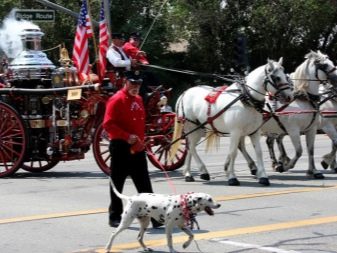
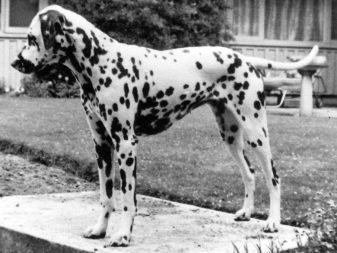
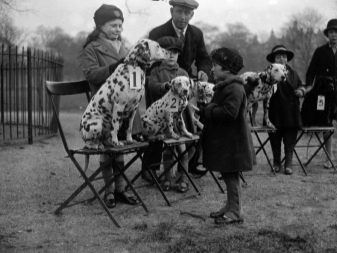
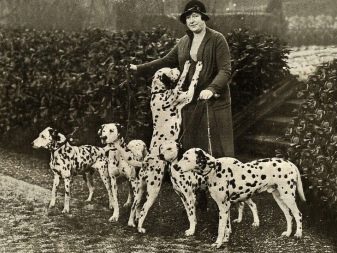
Dalmatians first appeared on the territory of modern Russia only towards the end of the twentieth century. (around the 80s), however, due to the too small population, breeding of the breed was very slow. The promotion of the breed on the market was also hampered by the banal ignorance of the majority of Russian breeders about the existence of this breed. The very first nurseries with individuals of Dalmatians, as well as official breed clubs, appeared in Russia only by the 90s of the twentieth century.
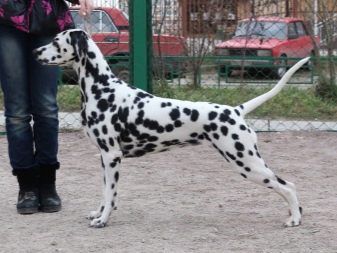
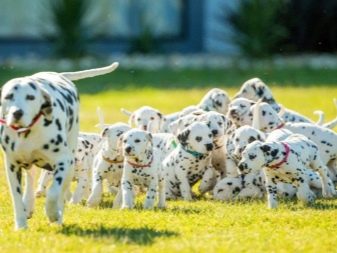
Description
Any officially recognized dog breed has a unique standard that defines its exterior. Consider the key characteristics of the Dalmatian standard.
- Head and muzzle. The head is proportional and flat, the muzzle is elongated. The characteristic stop is noticeable, the length of the muzzle is approximately equal to the length of the occipital part. There are no folds on the face and head.
- Ears. More than medium in size and hanging type, set wide apart and most often flattened to the head in a relaxed state. The shape of the ears is triangular, the color should be the same as the native color of the dog - with pronounced specks.
- Eyes. Small oval eyes. Set wide apart, not deepened. In the shade of the iris, dark brown tones prevail (for individuals with dark and black spots) and honey, brown and amber (with appropriate coloration). The gaze is focused, expressive, the eyelids fit snugly to the eye, up to the eyeball itself, covered with short hair with spotted pigmentation.
- Nose. Large, wide, well developed nostrils. It is identical in color with the general color of the breed - for individuals with black spots it is black, for individuals with brown spots it is chestnut.
- Jaw and teeth. The jaws are massive and strong, with a correct scissor bite. The upper jaw is slightly longer than the lower jaw, which allows the lower jaw and canines to be completely hidden. The lips must adhere to the jaw and do not form unnecessary folds.
- Neck. Long, strong, although quite thin. Flexible, allows the dog to turn freely around the sides.
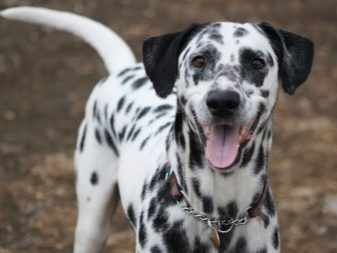

- Frame. Strong, slightly elongated and well proportioned. A large number of muscles are located on the shoulders and lower back. The chest is wide and deep, the ribs are vaulted. The back is straight, practically not tilted at the croup.
- Extremities. Long, straight and powerful, yet quite thin and elegant. The elbows should be close to the body. The hind legs are very muscular, the knees are well developed. The paws themselves are tightly packed, most often round or oval in shape.
- Tail. Long, massive, lightly pigmented or pure black or white. A distinctive feature of the tail is that it is perfectly straight, covered with a thin layer of wool and slightly tapered at the end. Thanks to this structure, the tail of the Dalmatians looks like a smooth wooden stick.
- Wool cover. The coat is thick and very dense, but short. Glossy tints on the sides and back are noticeable. The structure is tough, evenly covers the entire body of the dog - on the chest and in the genital area it can be slightly longer.
- Color. Regardless of the percentage of shades, the dominant color should always be exactly white. Frequent brown or black spots with clear edges are acceptable against a white background. All over the body, the spots should be the same color, while located on all parts of the body without localization in any specific place.
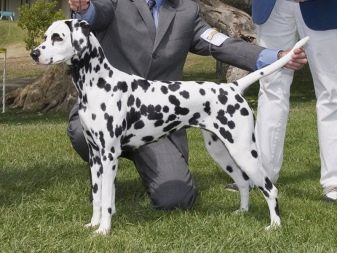
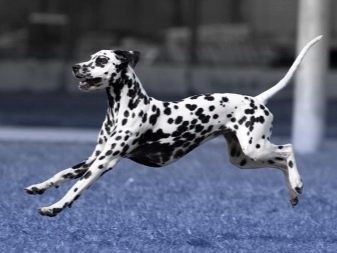
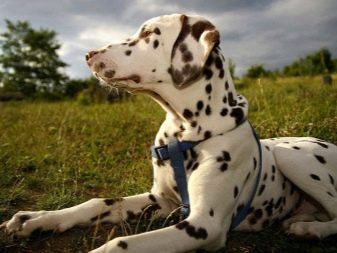
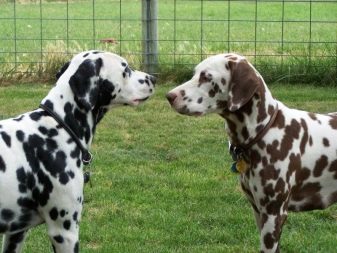
Common signs of Dalmatian dogs.
- The average weight of a female is 20-27 kg, an adult male is 22-32 kg.
- The average height of females at the withers is from 55 to 58 centimeters, of males - from 58 to 62 centimeters.
- Average life expectancy is standard - 10-13 years. Under ideal conditions of detention - up to 17 years.
- Country of origin - Croatia.
- Short hair is not a guarantee of the absence of shedding - quite the opposite, this breed sheds much more often than others.
- Approximately 12% of all newborn Dalmatians are deaf from birth.
- The unusual spotted color of Dalmatians is individual for each individual.
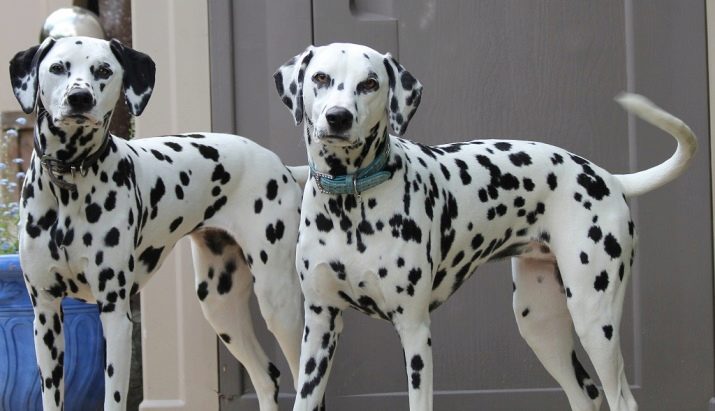
Character traits
Dalmatians are individualists not only in terms of appearance, but also character. These are unusually charismatic dogs with an extraordinary character.
These dogs are not suitable for owners who are used to sofa breeds of dogs. From the very birth, Dalmatians are surprisingly playful, active, they cannot stand to sit still for a long time, preferring to devote all their free time to games and entertainment. With insufficient physical activity, they become destructive - they can gnaw furniture, spoil interior items, or even snap at family members. In a state of excitement, these dogs are completely uncontrollable and do not obey any orders.
The main condition in upbringing is the designation of the owner in the role of the dominant. The fact is that these dogs need tough training with a lot of direct instructions, without empty rewards and handouts.
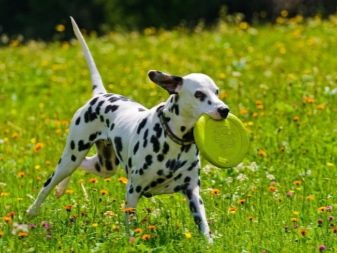

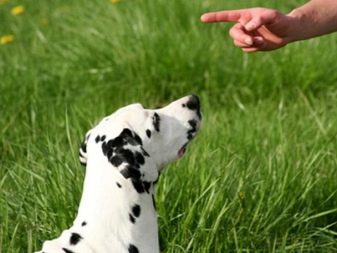
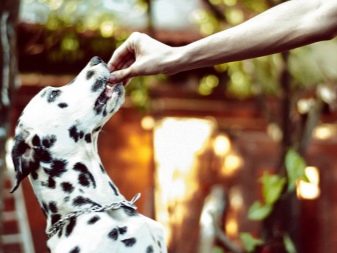
The dog must feel the authority of its owner, understand that some action and situation depends on the owner. If the owner cannot provide this, Dalmatians become surprisingly ill-mannered, capricious and restless, unable to carry out even the most banal commands.
This breed of dogs perfectly understands both its owner and his family members and strangers. They are able to very quickly assess the current situation and make informed decisions. Thanks to the sharp mind of the Dalmatians, it is easy to teach - they themselves strive to understand the owner and follow his commands. At the same time, delicacies here play a secondary role for them, the main goal is to win the approval of the owner.
The peculiarity of these dogs is that they are not prone to attachment to any one person. If Dalmatians grow up in a large friendly family, then they will equally protect and love each of its members. The good-natured and courageous nature allows Dalmatians to quickly establish contacts with dogs of other breeds. As for cats and other pets, the dog will also try to build relationships with them, but it will be too active for most animals. In their games and entertainment, Dalmatians can simply accidentally cripple their "neighbors".
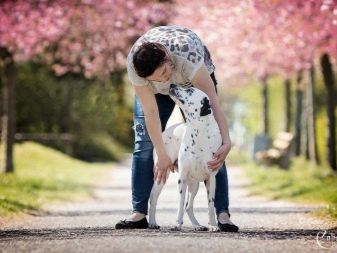
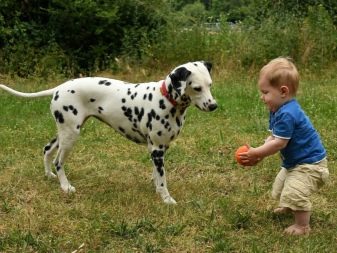


If we are talking about matured children (after 8 years), then with them the Dalmatians feel at ease. They feel in children the same irrepressible energy and attachment to active games. As for small children, Dalmatians will not be the best option for them. The fact is that most dogs often have hearing problems, which forces them to instinctively react to the slightest strange sounds and movements. At the same time, small children often do not follow their actions and can disturb the resting dog, and this will already lead to injury or severe fright of the child.
When it comes to guests or passers-by on the streets, Dalmatians are friendly and reserved. They will not rush into the arms of the first person they meet, but will allow themselves to be stroked and will try to treat the stranger with goodwill.


Dalmatians do not tolerate the manifestation of any violence against themselves, both physical and moral. With such an attitude, these dogs can become not only fearful, but also vindictive, aggressive.
What are they?
Today there are only two recorded species of Dalmatians: the black-spotted Dalmatians and the black-brown Dalmatians.
- Black-spotted appearance. The main difference between these individuals is clear black and white segmentation, where white always stands out behind the main color, and clear black spots are evenly distributed throughout the body. As a rule, it is the white (not cream) color that dominates in these dogs and the corresponding pigmentation of the nails is observed.The acceptable eye color for Dalmatians is precisely a dark color, however, sometimes there are defective individuals with blue and green irises, as well as with characteristic heterochromia. Such individuals are allowed to be represented at exhibitions only in the United States.


- Black and brown Dalmatians. These individuals are predominantly white with dark brown spots all over the body. The nose of such individuals is black or brown. Eye color can vary significantly, but it should be brown, amber, or hazel.
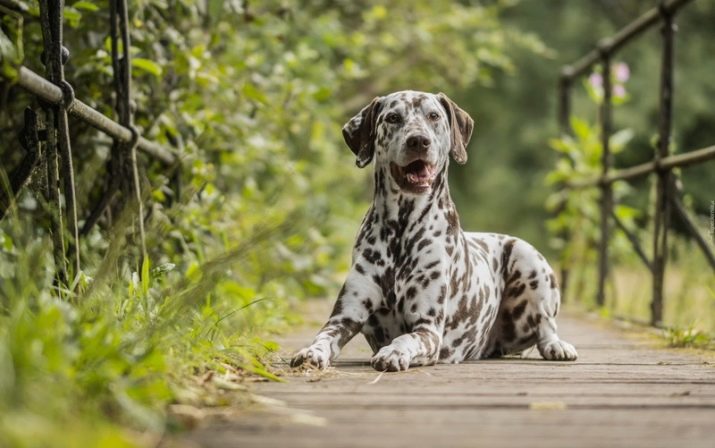
It should be said that today Dalmatians are actively interbreeding with other breeds of dogs, which leads to the creation of mestizos - representatives of mixed breeds. Such dogs also have a characteristic spotted color, but they can have dwarf growth, small paws, a thick and long coat, brown or even reddish shades of spots in color.


How to choose a puppy?
If you want to breed a Dalmatian at home, you should also carefully consider the procedure for choosing puppies for breeding. Below will be described the rules and recommendations that should be followed when choosing puppies of this breed.
- Age. The fact is that Dalmatians can be given into the wrong hands only after reaching 10-12 weeks. It is after this age that the puppies are already vaccinated against most diseases, accustomed to the tray and walking, they have formed their own diet. In addition, by this age, defects in appearance and some hereditary diseases are already noticeable. Particular attention should be paid to the hearing of the pet - for this, the pet should be taken for a BAER test. This test will determine if your pet has hearing problems.
- Appearance. Pay close attention to your pet's appearance. If you choose a show model, then the puppy should have all the external qualities. However, the pet's health status can also be determined by its appearance. Usually, the condition of the coat (wet, matted near the anus or genitals), the condition of the eyes (the presence of lacrimal paths), the evenness of the bones, the length of the claws, the cleanliness of the ears speaks a lot about problems with the gastrointestinal tract.
- Conditions of detention. Regardless of where your pet was bought, ask in what conditions he and his parents were kept. This will give you an idea of the breeder's integrity in caring for the pets.
- A prerequisite is a complete package of documents. In breeding farms and nurseries, you must be provided with a veterinary passport, metrics and pedigree of the puppy. When buying a pet from your hands, it can be difficult to obtain the entire set of documents, since not all breeders maintain such documentation. In addition to the documents, it will be useful to study the documents of the puppy's parents, so you will learn about hereditary diseases and predispositions of the future pet.
- Activity. Be sure to pay attention to the behavior of the puppies. It is always worth choosing exactly active individuals - this speaks of good health, stable character and dedication. These pets learn faster and tolerate exercise better.




What to feed?
In terms of nutrition, Dalmatians do not differ in some finickyness. They are absolutely omnivorous and adapt to any diet. In order for the diet to be balanced, it should include the following foods: white meat, fish, dairy products, vegetables and fruits. The peculiarity of feeding Dalmatians is that they digest natural food better. They may be allergic to artificial additives, as well as kidney stones.

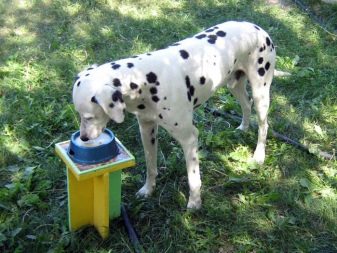
Ready feed
When it comes to feeding ready-made feed, then only premium or super-premium products are suitable for Dalmatians. It is these feeds that have a sufficient vitamin base and practically do not contain harmful soy elements. Modern feeds for active dogs offer blends with a huge amount of protein, however, for a Dalmatian, such food will be useful only for the first time. Here it is worth referring to foods intended for medium-sized dogs.


In eating dry food, water occupies a very important place, which is why kefir or vegetable oils are added to ready-made mixtures. These products strengthen the coat, making it thicker and richer in color. When feeding ready-to-eat foods, be sure to refer to the instructions. Particular attention should be paid to this norm in the very first days after the appearance of the pet in your home. Eliminate additional vitamins from the diet when feeding the dog with ready-made feeds - they already contain everything you need.


It is not recommended to combine the diet - you should choose to feed the dog with either natural or prepared foods.
Natural products
A common mistake inexperienced breeders make when feeding a dog is to only serve white meat. The fact is that the main condition for feeding Dalmatians is precisely the variety of food in the diet. It can be both nutritional supplements and vegetables that provide the body with the necessary vitamins.
In order for meat products to be well absorbed in the body, they should be treated with boiling water and cut into small pieces (especially when it comes to feeding very young puppies). It is worth choosing varieties with a low fat content: lamb, beef, rabbit, chicken is also suitable.
It is better to give meat products at night, so that the dog's body can calmly assimilate all the components during the animal's rest period. In the morning, they usually give light and hearty food - cereals and vegetables, which will give the pet strength for fun and training.

Cereals and cereals from cereals also show themselves well as a healthy food for a Dalmatian. It is best to use barley, buckwheat (on water) and millet. It is worth abandoning oatmeal - it has been proven that the dog's coat begins to acquire an unpleasant yellow color from it.
Fresh vegetables are also an indispensable element in the diet of a Dalmatian. For this, both raw vegetables and fruits (apples, peppers, carrots, celery) and boiled vegetables are suitable.
A good substitute for meat would be sea boiled fish, as well as some offal. To diversify the diet of a Dalmatian, it is recommended to occasionally include curd products, cheese and eggs (hard-boiled).


When adding new foods to food, first make sure your pet is not allergic to them by visiting your veterinarian and having food allergy tests. Common allergens are egg white, some cereals, and foods with a high acidity level.
Inexperienced breeders sometimes confuse the insatiable appetite of the Dalmatians with the insatiable hunger. Sometimes the pet will eat food quickly on purpose to demonstrate a desire for supplementation. If this behavior persists, try increasing the amount of food a little. Although most Dalmatians can determine the amount of food they need, you should still be careful about portion sizes. Excess weight can lead to the development of many serious diseases, including the cardiovascular system.

Natural food is considered to be healthier and more nutritious than ready-to-eat food, but it needs additional vitamin supplements. Usually, this need is more manifested in winter, when dogs have a high chance of contracting colds and viral diseases.
Sometimes Dalmatians show a complete reluctance to eat at the moment. If this is an isolated incident that lasts several days, don't worry. This breed of dog can occasionally arrange for itself the so-called unloading, when the animal digests the already received food and distributes proteins and carbohydrates in the body.
Each type of feeding has its positive and negative aspects.

Feeding prepared feed
Pros:
- the possibility of long-term storage of large amounts of food;
- high-quality ready-made feeds a priori contain the whole complex of vitamins and minerals necessary for a dog's life;
- there are no problems with balancing nutrition, ready-made feed contains the optimal amount of protein, fats and carbohydrates;
- you do not need to constantly check the portions of prepared food, usually their size is indicated on the packaging of any of the foods.
Minuses:
- feed of premium class and higher cost a round sum, especially when it comes to large volumes;
- in such a diet, the variety of food is lost, since the pet always receives the same food;
- the content in the feed of a large amount of protein, which is harmful to the body of the Dalmatian.
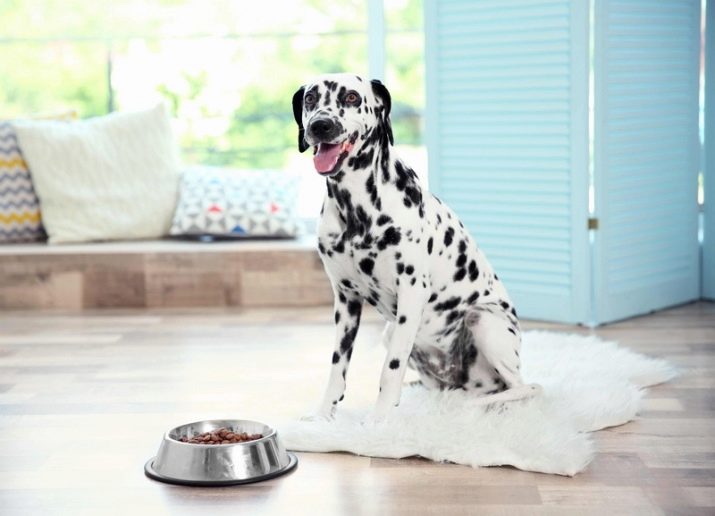
Feeding with natural food
Pros:
- relatively low cost;
- the ability to independently adjust the quality of food and its calorie content;
- in feeding with natural food, it is easy to change the diet, diversify it by adding a new product.
Minuses:
- the need for regular preparation of fresh food, since the portions are suitable for consumption only for a short period of time;
- the difficulty of constantly calculating the calorie content and the ratio of protein, fat and carbohydrates.
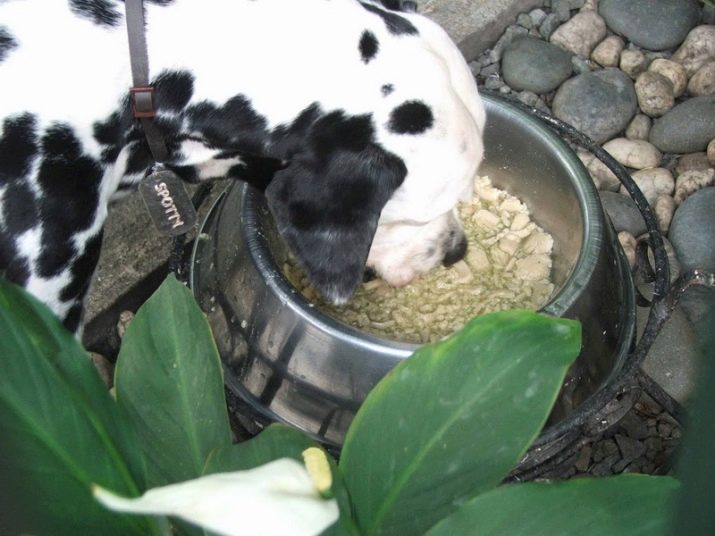
Nutrition according to age
The diet, as well as the frequency of feeding in adults and young individuals, is often very different. For example, already an adult animal will need a strictly balanced diet with a limited amount of protein, as well as the presence of vitamins and minerals. If we are talking about a young or newborn puppy, then it should be fed at least 4-5 times a day in small portions. With the passage of age, usually every 3 months, one meal is removed from the diet, and the portions themselves increase. Thus, by about 10-12 months, the pet should eat no more than 2 times a day.
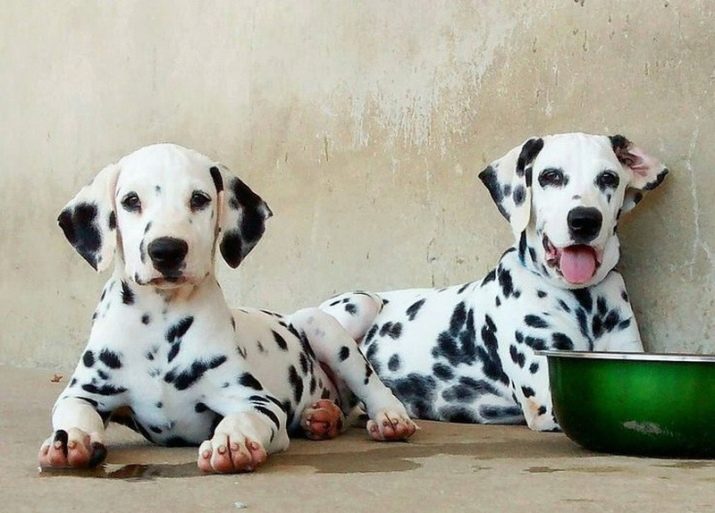
In no case should a Dalmatian be given bones until one year of age. Until this period, the pet's teeth are actively changing, and the bones can damage their structure. Feeding with mixtures of ground bones and meat, as well as offal and cartilage, is a good option. Also, Dalmatian puppies need at least two servings of fresh cottage cheese per week. To make the curd more attractive to the pet, you can add honey, fruit or glucose there. Cottage cheese not only strengthens the bones of the animal, but also has a positive effect on the skin, improves the functioning of the nervous system, and also counteracts allergic processes.
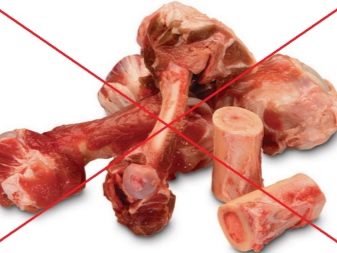
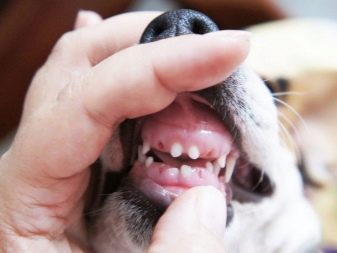
How to care?
Dalmatians are not fastidious in terms of grooming or keeping dogs. They are distinguished by cleanliness, do not like dirt and water. Unlike other dogs, Dalmatians do not moult at any particular period of the year, but literally constantly. That's why, despite the thin layer of wool, most of the time will be spent on caring for the hair... The only thing that can save you in this situation is regular brushing or keeping the pet outside the apartment (in the case of a private house). Brushing will not only remove the extra layer of hair, but also bring it to a well-groomed look. For a thorough grooming of your coat, you will need a soft-toothed brush or a soft round comb.
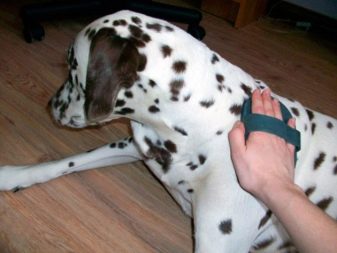
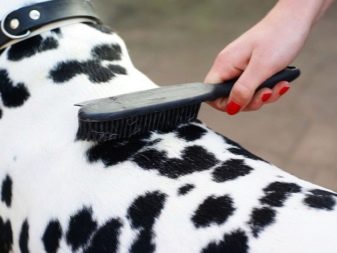
Keep in mind that too frequent brushing weakens the hair and loses its color saturation.
Some inexperienced breeders habitually wash Dalmatians to get rid of the characteristic canine odor. However, the fact is that these dogs do not have this smell at all. The first bathing should be carried out no earlier than the pet is six months old. Before this age, there is too great a chance of damaging the natural fatty layer of the skin. As with other dog breeds, Dalmatians should not be washed too often - once every couple of months will be enough.If your dog just gets dirty while walking or exercising, use plain water without detergents to wash it.
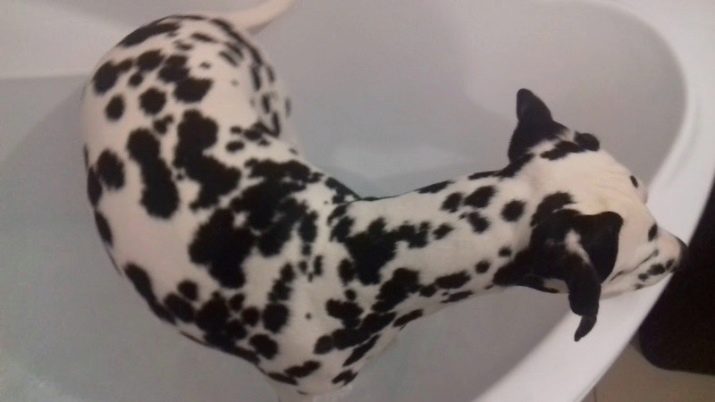
When caring for Dalmatians, considerable attention should be paid to the condition of their ears. Due to their location, they can become dirty very quickly, which leads to inflammation and allergies. The condition of the ears is determined by the smell, as well as the intensity of the release of sulfur. If there is no unpleasant smell, as well as dirt, your pet's ears are in good condition. You need to clean your ears using cotton swabs slightly dipped in boiled water.
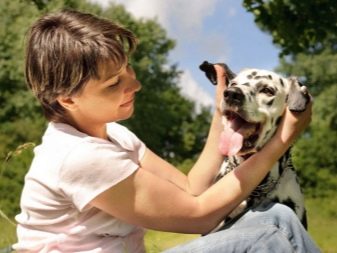

Unlike other dogs, Dalmatians often have a delayed development of the dentition. The problem here is that deciduous teeth can interfere with the development of a number of permanent molars. If you notice that the dog's gums begin to bleed, and molars begin to erupt under the milk teeth, immediately take the pet to the dog's dentist and remove the upper teeth. If the top tooth is loose or loose, you can try to remove it yourself - wrap the top tooth with clean gauze and swing until it falls off by itself.
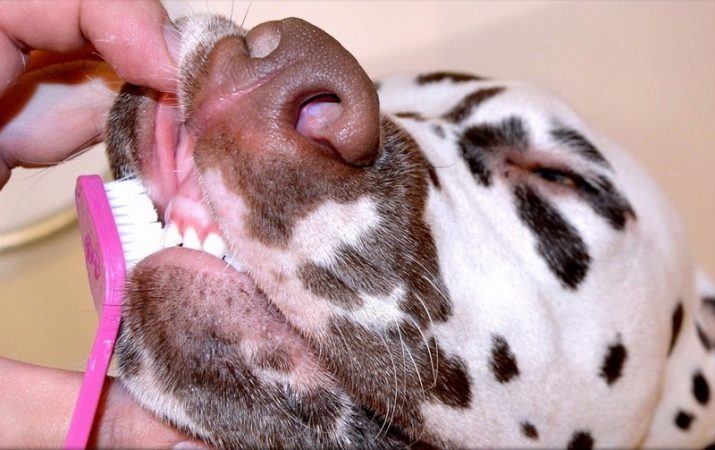
The difficulty of doing such a procedure at home is that not every owner will simply make the dog behave calmly. Removing milk teeth allows the dog to form a healthy bite faster and not experience discomfort while eating.
Another problem in dental care is the formation of tartar and plaque. In addition to causing gum inflammation, plaque can make the dog look unattractive and can interfere with the eating process. You can also remove a thin layer of plaque at home - for cleaning your teeth, special powders and ointments are sold that remove plaque. A good budget option for cleaning your teeth from plaque is lemon peel. It contains acids that have a destructive effect on the accumulation of matter. The tartar itself is easily removed using a special spatula (metal or wooden) - they are sold in every pet store. So that in the future tartar does not appear so quickly, you should add tomatoes or tomato juice to the dog's diet.
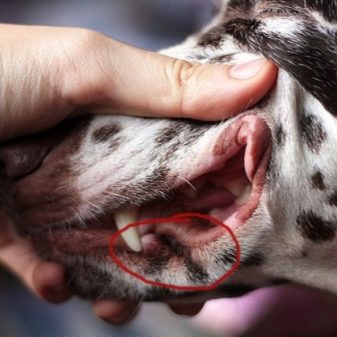
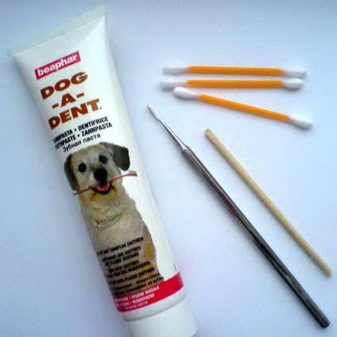
In this breed of dogs, deformed claws are often observed, which not only interfere with the dogs' full movement, but also injure the paws of the animals. It is worth starting to clean the claws from childhood, and this is useful for both exhibition and domestic individuals. Long claws prevent the paw from gathering into one lump, which impedes the dog's movement and leads to inflammatory processes on the pads.
White claws are much easier to cut, usually you can see where the pink level ends inside - this reduces the chance of injuring the dog's paws. If your dog's nails are black, trim the nails just below the curve.
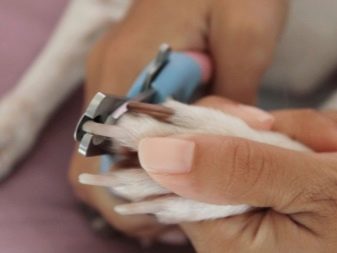

Dalmatians, despite their restless disposition, should always have their place. The pet will come there when it gets tired or when it needs to sleep. The place should be close to the owners - the dog should see that he is not alone. You can also make him booths and houses in the open air - Dalmatians love the street in summer and spring. As soon as the cold sets in, the animal should be taken into the house - the Dalmatians do not have enough wool to survive the winter painlessly.
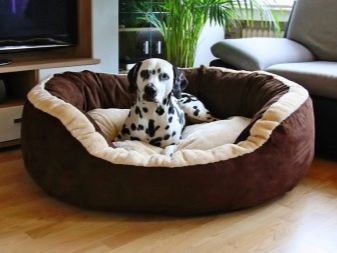
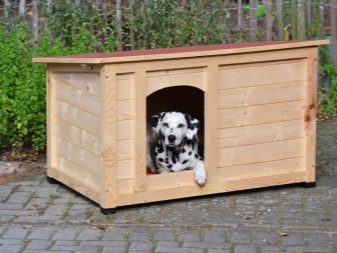
Keeping in aviaries in the case of this breed is unacceptable, Dalmatians should always be in the field of view of the owner and have full scope for action on the territory.
Dalmatians are constantly in need of physical activity. They need to be walked at least 2 times a day, while being taken to special areas for training dogs. If your pet is unable to realize all its energy on the street, be prepared for the consequences within the walls of the apartment.The pet will express its energy through aggression, capriciousness and destructive behavior - damage to furniture, minor mischief, aggression towards other pets.
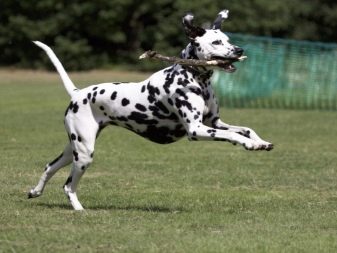

Upbringing
Dalmatians need special training; standard training models are not suitable for training these dogs. It is also undesirable to use the services of dog handlers to train your dogs. The fact is that a lot of the success of training this breed depends on the authority that you must form in your pet. If this authority is formed in relation to the trainer, it is likely that the dog will not obey you.
Despite their high intelligence, the effective teaching of Dalmatians is greatly hampered by their irrepressible energy and constant desire to explore everything that is around. In addition, this breed is unusually freedom-loving and will act in its own way if it feels the weakness of the owner.
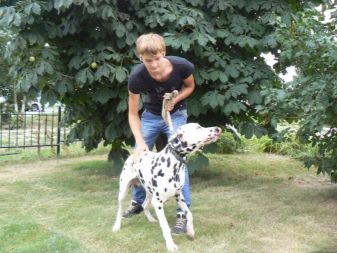
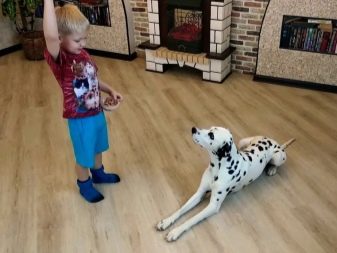
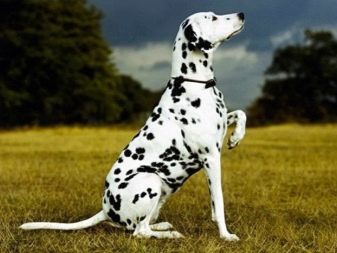
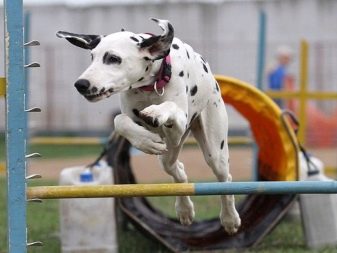
Training a Dalmatian should be done at a young age, and the sooner, the better it will be for you and your pet. As soon as the pet steps on the threshold of your house, immediately mark its place, as well as areas that are closed for visiting. This could be a bed, bathroom, balcony, closet, or any other space.
The sooner you find a suitable nickname for your pet, the sooner he will get used to it and begin to respond to it. In the future, using a nickname in front of commands will help you focus your pet's attention on a specific task. The nickname must be short and sonorous - the pet must remember it and distinguish it from other sounds.
Try to suppress loud judgments or even physical violence against your dog. Beating will only lead to aggression, disobedience, whims and fears. Express your dissatisfaction with your tone of voice without raising the tone. Don't worry, the Dalmatian will very soon understand when you are angry and when you are happy.
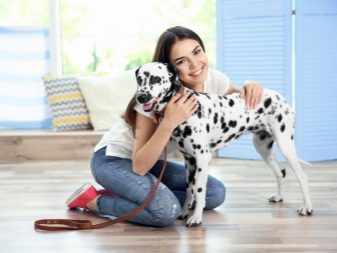
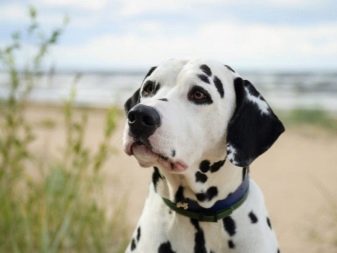
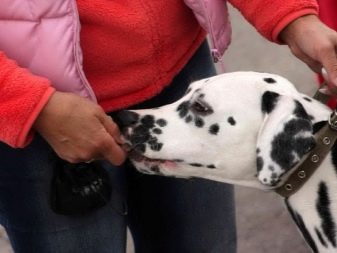
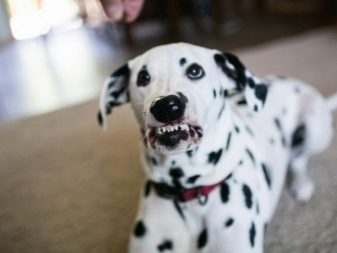
Use both your voice - affectionate words, mild adjectives, and treats and treats (for example, small bones specially for training) for encouragement. The pet must understand that by performing a certain action, he can receive a tasty reward.
Try to drive your pet to crowded places more often. It can be either an ordinary walk on the street or an active pastime in the city surrounded by a large number of people. A Dalmatian must learn to behave calmly within a large group of strangers. In this case, you must act as a defender who will come to the rescue in case of danger. If you are going to take your dog to playgrounds (especially for dogs), make sure that your pet is vaccinated against all infections and viruses.
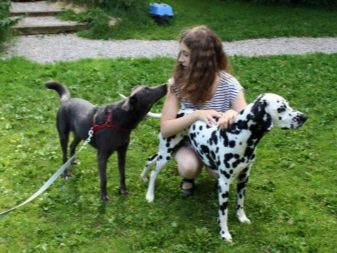

The first step to learning is getting used to simple commands. The list of such commands includes the following: "sit", "paw", "voice", "up", "to me." Up to six months, it would be nice to teach the pet to respond and react to its own nickname. Once this command base is mastered, start learning more complex commands that require long-term action: "next", "lie down", "aport", "take" and others.
Gradually move from commands to physical activity. Try to visit the playgrounds more often, develop a command system specifically for your site with certain simulators and obstacles.
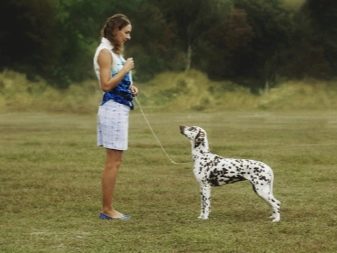

Do not forget to return to the covered material - repetition will only consolidate the covered material and make the execution of commands automatic.
One of the main conditions for training is regularity and consistency. Try to hold classes at a specific time every day. If initially training will take you no more than 20 minutes due to the restless nature of the dog, then by the age of one year, they should increase to one hour.The time for training should be chosen before breakfast or before dinner, so that the pet has the motivation to follow the commands for the treat.
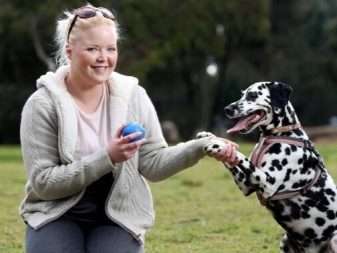

Popular nicknames
Owners, when choosing a name for a Dalmatian, quite often give preference to nicknames that reflect the unusual color of the breed. The following names are used here: Figaro, Blot, Zebra, Bim (by association with the story "White Bim Black Ear"), Harlequin, Marble, Jade, Star, Africa, Dune, Flora, Snow White.
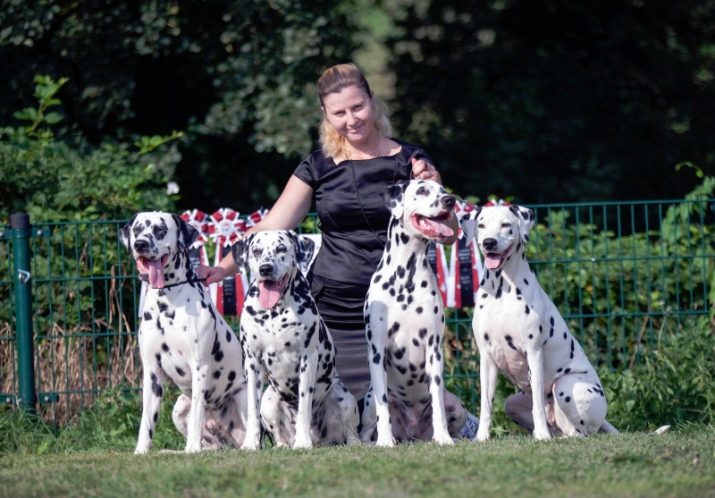
When choosing nicknames for your pet, you can focus on a number of associations. Below are examples of good nicknames for Dalmatian boys and Dalmatians girls.
- association with natural phenomena: Rain, Grad, Tuchka, Cold;
- expression of pedigree: Count, Ideal, Lord, Countess, Prince, Lady, Lady;
- associations with flowers: Chamomile, Buttercup, Burdock, Peony, Aster, Hyacinth;
- associations with celestial bodies: Star, Moon, Neptune, Mars, Uranus, Jupiter;
- expression of activity and speed: Whirlwind, Storm, Instant, Lightning, Tikhon;
- you can also name a pet in honor of a famous person: Napoleon, Caesar, Julius, Cicero, Tiffany, Rose, Berta, Sophia;
- associations with mythological personalities: Loki, Zeus, Athena, Venus, Perseus, Neptune, Nika, Juno;
- nicknames by the names of a certain territory or geographical object: Vienna, Nile, Paris, World.


Often the owners of Dalmatians are not limited to any framework and call their pets quite wonderful names, which, in their opinion, can reflect the extraordinary appearance and character of the dogs.
Owner reviews
Absolutely all owners speak of Dalmatians as kind, intelligent and extremely talented animals that can support in difficult times. Everyone notes the Dalmatians' love for mischief, as well as their affection for children and other dogs.
On the negative side, some complain about the problems of grooming a pet's coat - it seems that not all breeders expected that from such a seemingly short hairline there could be so much debris and dirt.

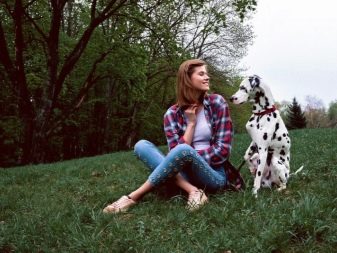
For the history of the origin and characteristics of the Dalmatian breed, see the following video.






































